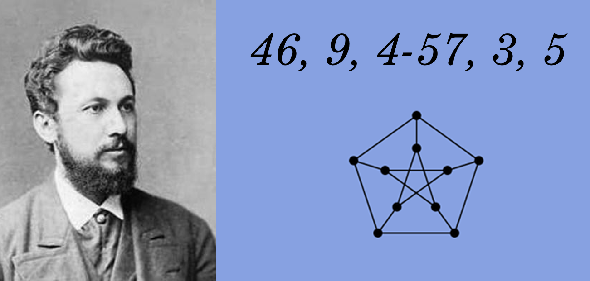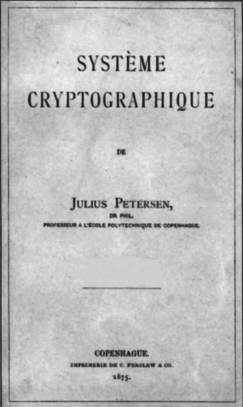This is the shortest cryptogram I have ever introduced on this blog: 46, 9, 4-57, 3, 5. Can a reader decipher it?
Julius Petersen (1839-1910) was a Danish mathematician, whose work led to the birth of graph theory. He ist best known for Petersen’s theorem (“every cubic, bridgeless graph contains a perfect matching”), and the Petersen-Morley theorem.
Moreover, he created the Petersen graph, which looks like this:
Petersen’s cipher signature
Julius Petersen also had an interest in encryption. In 1875 he published a cryptography pamphlet titled Système cryptographique written in French (I haven’t found this pamphlet online, does a reader know where it is available?).
A principle emphasized in this pamphlet states that the security of a cryptosystem must not depend on keeping the crypto-algorithm secret. Instead, the security should depend only on keeping the key secret. This concept is today known as Kerckhoffs’ principle, named for Auguste Kerckhoffs (1835-1903), who stated it 18 years after Petersen, in 1893.
Petersen also wrote (or co-wrote) a series of eight fortnightly articles on cryptography for a weekly magazine named Nær og Fjern (if a reader knows where these articles are available, I would be interested, too). These articles were published under the following pseudonym:
46, 9, 4-57, 3, 5
As it is not clear whether Petersen was the sole author of this article series, it is not known if this pseudonym refers to him alone or to a group of persons he belonged to.
The meaning of 46, 9, 4-57, 3, 5 is unknown. It is the shortest cryptogram I have ever written about on this blog (except for the infamous Riverbanks Ripper cryptogram, of course).
Many comments, no solutions
My main source for the Petersen signature (except for a Cryptologia article from 2006) is a blog post written by Nick Pelling in 2010. It received 20 comments. Four years later, I wrote my first blog article about this mystery (in German), which was commented by my readers, too. Some of the comments were quite interesting:
- René Zandbergen remarked that 46, 9, 4-57, 3, 5 might stand for two dates (perhaps 1846-09-04 and 1857-03-05). Are these the birth and death dates of a person who died in the age of eleven?
- Ernest Lillie wrote: It looks like a book code. I’d speculate that it goes something like: Page 46 — Line 9 — Word 4 = Julius; Page 57 — Line 3 — Word 5 = Petersen. It would make sense if the book used as the key had an alphabetical listing of names and ran to about 90 pages. Worldcat says that “Système cryptographique” has 15 pages so no joy there.
However, none of these comments led to a solution. So, four years after my first try, I decided to introduce this cipher mystery on Klausis Krypto Kolumne again. Are there any new ideas about this short cryptogram? If so, please let me know.
Follow @KlausSchmeh
Further reading: The silk dress cryptogram: New evidence, but solution still not found
Linkedin: https://www.linkedin.com/groups/13501820
Facebook: https://www.facebook.com/groups/763282653806483/






Kommentare (30)